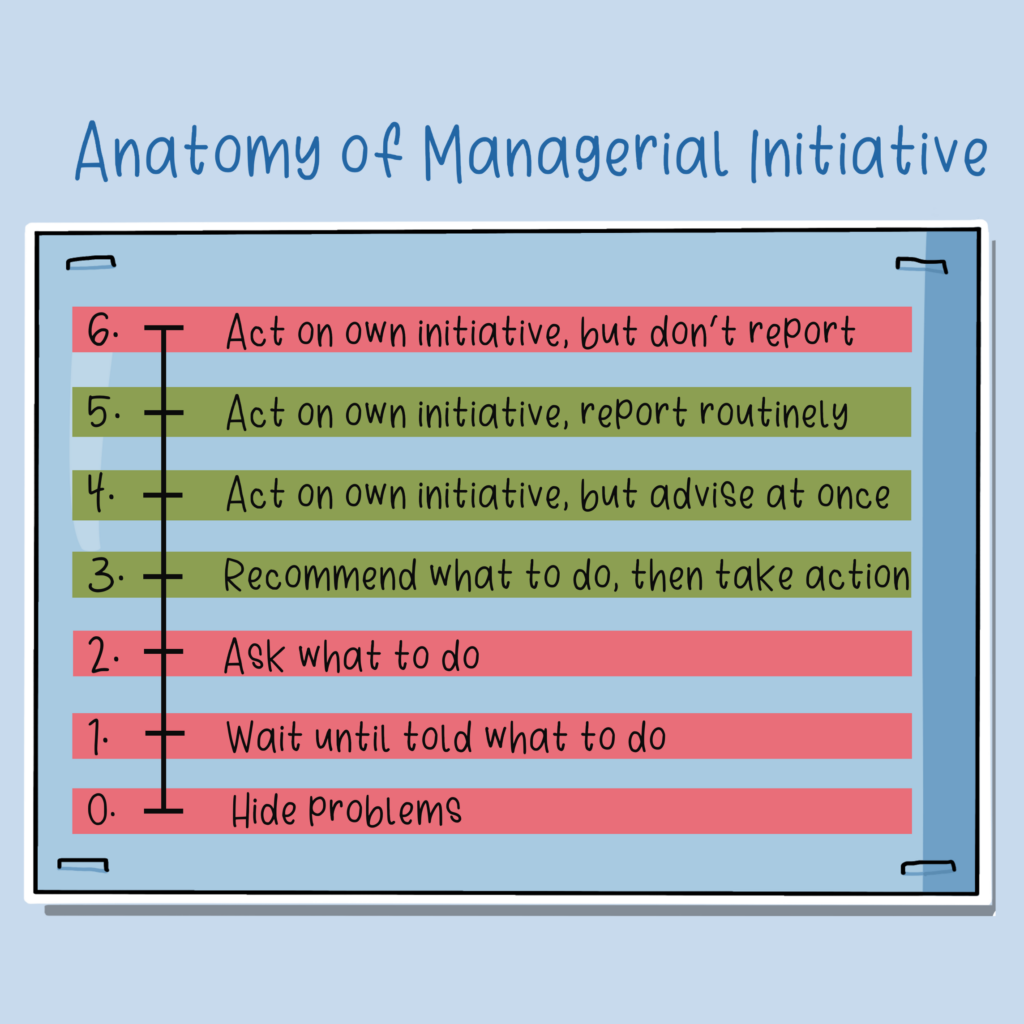

When discussing with clients how to lead their staff, one question that arises often is, how much initiative should my people show? In their classic HBR article, Management Time: Who’s Got the Monkey? Oncken and Wass lay out a five-level scale of managerial initiative (1 – 5 in the figure). My clients’ staff are more resourceful and so I’ve added two more levels to the original model, 0 and 6.
Level 0, actively hiding the problem, never made it onto their scale, yet it seems to have been a beloved strategy in the financial services industry in recent years. The presence of Level 0 is a sign that a company needs urgent organizational developmental help. It is hopefully not occurring in your place of work (and, so, not on this graphic).
Level 1 describes the behaviour you would prefer to eliminate from your own working habits, as well as those of your subordinates. People who indulge in this have no control over their time or the content of their work – it increases the chances that the working day turns out to be full of (stressful) surprises. Leaders who encourage this behaviour get what they ask for: overworked, poorly motivated yes-persons.
In classical management (and the scale was written in 1975), Level 2 is also a candidate for banning. Oncken & Wass recommended that managers never indulge in this behaviour, since it can surrender control over the content of one’s job. However, understanding of leadership has developed over the past thirty years, so we need to be careful here. An unthinking, “what do I do now, boss?” deserves to disappear. However, thoughtful questioning to elicit understanding of a problem and to identify possible next steps belongs in any leader’s toolkit.
Many managers, when they first see this scale, state that it’s impossible to get subordinates even to Level 3. In practice, it’s not too difficult: As long as you have basic mutual respect, you only need to make a habit of asking people for their suggestions to get them into the habit of bringing suggestions to you, and not just a problem for you to solve. They’ll get the hang of it and save themselves the routine question.
As trust and understanding of how each other works develops, staff will naturally arrive at Levels 4 and 5 over time. Part of this development involves exposing people to your thinking processes in decision-taking and values, so that they have a good idea what’s expected; they won’t get it by osmosis or telepathy. I recently spoke with one senior manager who was frustrated that his secretary was not screening his e-mails adequately. It turns out, he expected her to know which ones deserved his attention, which ones should be diverted to other people, and which ones binned. He has now scheduled some time with her, so that they can go through his in-box together, and she can understand how he would like her to deal with his mails.
At first, many people don’t see a problem with Level 6. Indeed, when managers are suffering from data overload (too many mails, messages, meetings), it can be tempting to allow staff to drift towards Level 6. However, you lose the overview of what’s going on, which impairs your ability to lead. One client, Director of Sales & Marketing, was delighted about how much initiative his staff showed. It was only when his department began to miss its targets that he realized his sales team was neither sharing important customer information with him nor each other. During their next meeting, they looked together at how their enthusiasm and independence was turning counterproductive, and moved back to Level 5. Sales improved in a tough market.
What strategies work for you to help your staff demonstrate appropriate initiative?


